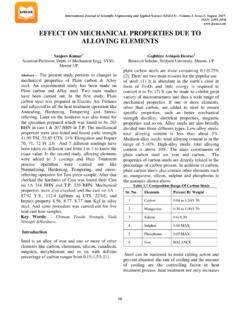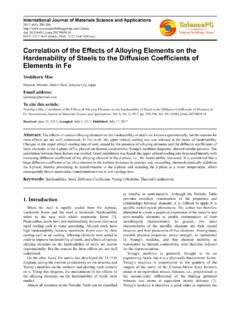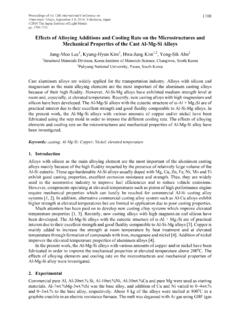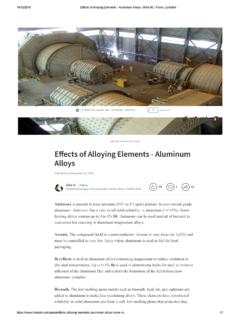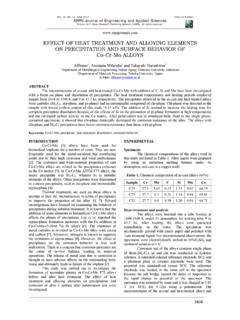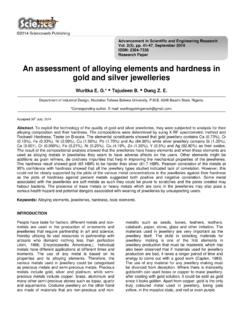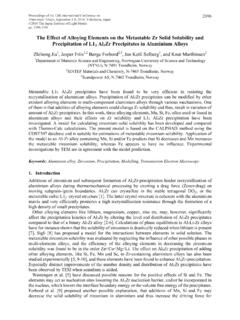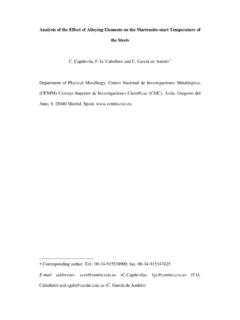Transcription of The Effects of Alloying Elements in Steel - St. Louis, MO
1 Page 1 The Effects of Alloying Elements in SteelAl ALUMINUMWhen added to molten Steel , mixes very quickly with any undissolved oxygen and is therefore considered one of the most common deoxidizers in making Steel . Aluminum also is used to produce a fine grain structure and to control grain CARBONP roduces the properties in Steel that gives it such great value. As carbon content increases, there is a corresponding increase in tensile strength and hardness. Additionally, as carbon content increases, Steel becomes increasingly respon-sive to heat CHROMIUMLike carbon helps the response to heat treatment.
2 An increase in depth of hardness is also noticed with its use. When used in large quantities, possesses a remarkable resistance to oxidation and erosion used in conjunction with other alloys. Chromium is one of the popular Alloying COPPERIs usually added in amounts .30% and helps Steel resist corrosion. It also helps in some degree to increase ten-sile and yield strengths with only a slight loss in IRONA lthough it lacks strength, is very soft and ductile, and does not respond to heat treatment to any degree. Iron is the primary element in Steel .
3 With the addition of other Alloying Elements required mechanical properties can be LEADIs used in Steel to improve machinability. In small amounts of .15 .30% and finely divided and distributed, it has no known effect on the mechanical properties of COBALTIs used to increase the red hardness of a Steel . It adds much life to a tool by its ability to maintain hardness and cutting ability when it s heated to a dull red during a machining MANGANESEIs next to carbon in its importance in Steel making. This is due primarily because of its ability to resist hot shortness or the tendency to tear while being forged or rolled.
4 Manganese is used in just about every Steel made and increases responsiveness to heat treatment and acts as a MOLYBDENUMR aises hot strength, has good creep resistance and helps Steel resist softening at elevated temperatures. It is used to a large extent in tools and dies intended for the hot working of NICKELI ncreases strength and toughness and has good fatigue resistance. Steels with nickel usually have more impact resis-tance than steels where nickel is absent. This is true especially at lower 2 The Effects of Alloying Elements in SteelP PHOSPHORUSIs seldom deliberately added to Steel but is carried as a residual or incidental element.
5 When it is added it is usually for the purpose of machinability. Phosphorus is present in all steels and tends to increase resistance to corrosion while increasing yield SILICONIs the most common deoxidizing agent. In amounts up to 1% it has a marked strengthening and toughening effect . In higher amounts it produces electrical resistance and give high magnetic SULFURIs usually found in all steels and like phosphorus is considered machinability. The amount for this purpose is usually from .06 Sulfur is considered the basic element for free machining Steel .
6 It is however, detri-mental to the hot forming TUNGSTENP romotes red hardness and hot strength in addition to producing dense grain and a keen cutting edge. These properties make Tungsten Steels very useful for hot working applications such as cutting tools when the Steel is hot enough to be low red in VANADIUMIs a strong deoxidizer and promotes fine grain structure. It helps Steel resist softening at elevated tempera-tures and seems to resist shock better than steels without Metals(800) 229-78429550 Watson Industrial Park, St. Louis, MO

